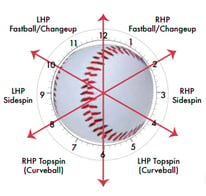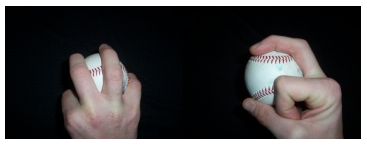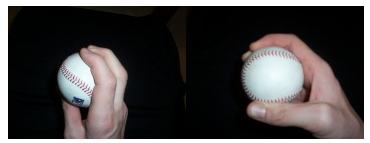Best Pitch Grips for Baseball Pitchers
Youth Pitchers often experiment with pitch grips by what they see on YouTube, TV, or just what "looks cool." Despite their best intentions, youth pitchers that play around with their pitch grips can significantly hurt their chances of throwing strikes or possibly their arms by not utilizing the correct grips and delivery.
These are the five most common pitch grips that youth pitchers (with pitch grips 4-5 below being more for advanced, mature pitchers) should master (both from how they throw the pitch to the spin direction of the pitch when it's released per diagram below) before taking the mound.

 Image source: baseball-pitching-tips.com
Image source: baseball-pitching-tips.com
1. Four-Seam Fastball. The four-seam fastball is the most popular pitch grip in all of baseball. Pitchers are attracted to it because with it you can pitch with pinpoint accuracy (and at the higher levels of baseball, you can produce a high spin rate with a four-seam fastball that provides some "life" to the fastball). According to Rapsodo, "the spin direction (axis) of a pitch is based on the face of a clock from the pitcher’s point of view at ball release, 12:00 is all backspin (a true 4-seam fastball-type spin)." It is a pitch that pitchers can always rely on to throw for a strike. The Four-Seam Fastball is the first pitch grip every youth pitcher should learn how to throw and they should not deviate from this grip until they have really proven they can throw consistent strikes with the four-seamer.
 Image source: baseball-pitching-tips.com
Image source: baseball-pitching-tips.com
2. Two-Seam Fastball. The second-most common pitch in the big leagues is the two-seam fastball or sinker. In MLB, this pitch averages above 90 mph, but even youth pitchers can use this pitch to get a little more movement on their fastball. Just like the name, the two-seam fastball will sink and possibly break outside of the strike zone and can have considerable "arm side run" where the ball runs to the arm side of the release point. To see a great two-seam fastball, we can look at MLB Pitcher Zach Britton. Here you can see an example of how effective his two seam fastball is as it sinks and moves out of the hitter's bat path.
 Image source: baseball-pitching-tips.com
Image source: baseball-pitching-tips.com
3. Changeup. Exhibiting the opposite usage pattern as the slider a change up is used by ten percent of all MLB pitchers. When using this pitch, most pitchers will only use it on a batter who is batting opposite of their throwing arm (for example, a right handed pitcher will throw it low and away to a left handed hitter and vice versa). The key to the changeup is to throw it from the same release point as the fastball and not slow down the arm when throwing it; essentially, a changeup will be naturally slowed down in terms of velocity because of the type of grip being used. The most effective change ups in terms of pitch sequencing are thrown after a batter is aggressively timing up a fastball. Hall of Fame Pitcher Tom Glavine used to throw a Circle Changeup which is where a pitcher creates a circle with the index finger and the thumb to grip the baseball. As Complete Pitcher said, "By pronating the wrist upon release, this pitch tends to break slightly in the same direction as a screwball. More or less break will come about from the pitcher's arm slot. The more three-quarters or side-arm angle, the more break generally."
 Image source: baseball-pitching-tips.com
Image source: baseball-pitching-tips.com
4. Curveball. According to MLB stats, curveballs account for only 9.9% of all big league pitches thrown. Although they do produce an overall location signature similar to the slider, they do not yield differences nearly as drastic in terms of frequency or efficiency. The curveball is also, by far, the slowest MLB pitch and can sometimes referred to a breaking ball more than others as the topspin of the ball causes the ball to "break" in an arc like fashion. The curveball should not be taught at a young age unless the grip and delivery is clearly taught without exposing the arm to injury. For example, Dr. Tom House says, "Thrown properly, curveballs put less stress on the arm than a fastball." Typically, that is the case because the curveball taught by Dr. Tom House is released like a "karate chop" and there's no twisting motion. As stated by Dr. House in Baseball Prospectus, a player should "karate chop the curve ball, which puts the palm on the outside of the ball, the thumb and middle finger cutting through the middle of the ball, and that’s what imparts proper rotation, safely."
 Image source: baseball-pitching-tips.com
Image source: baseball-pitching-tips.com
5. Slider. The slider, which makes up 14.1% of all MLB pitches thrown and travels at an average speed of 83.9 mph. Pitchers will favor this type of pitch when the batter is batting from the same side as they are. This pitch tends to "slide" away horizontally from the hitter's bat path as opposed to breaking down like the curveball does. This causes the batter to swing thinking it will be higher than what it really is. It makes it hard for the batter to see where it will end up, it tends to break early (curveballs break later typically than sliders), and has baffled many hitters in the big leagues. Youth pitchers should not typically use this pitch grip and type of pitch until their arm and shoulders are more developed.
